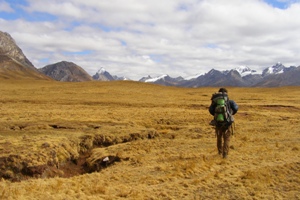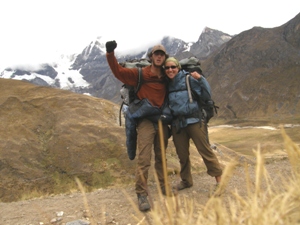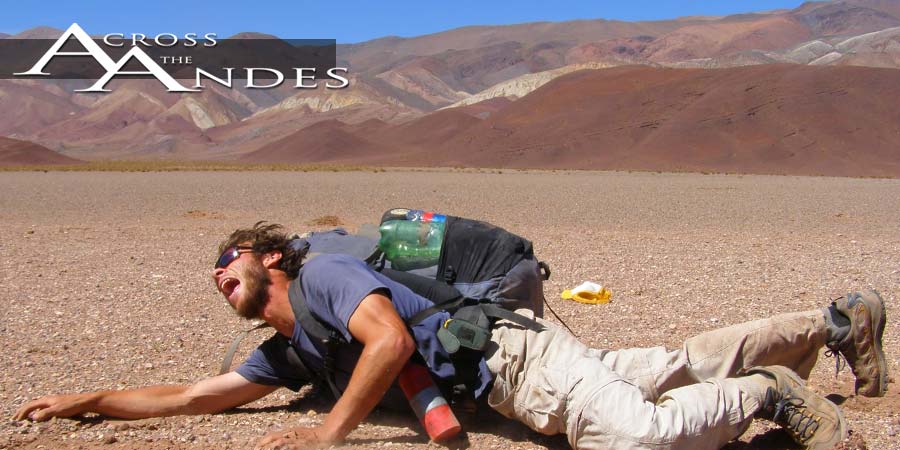End of a Section
By Gregg Treinish

We had finally reached Santa Teresa, and would begin the walk just after the next beer. The sun was set, and we had decided that getting to the ruins as quickly as possible would be best. An Australian, and two Israelis would accompany us on the two hour hike up to the base on the mountain on which sits historic Machu Picchu. We had heard from several people that we may be able to avoid the outrageous $50 fee the INC charges if we left early in the morning. We figured 3:30am would be a good time as it would also afford us the opportunity to see the sun rising over the ruins. By Four o’clock there was already a steady line of people on the trail up. Apparently the secret had spread. I wasn’t expecting too much from the ruins. Visiting the number one tourist attraction in South America was something that had to be done, but that I was sure would have its compromises. We emerged from the jungle covered in brush, and after scaling a small wall, we were in… “Where is it?” Chris, our Picchu friend asked; we all knew very little about the site itself. It was only a few seconds until someone turned around. “There,” a voice rang out. It had been below us for half our climb. It was a special moment. A picture does Machu Picchu no justice at all. We have seen bigger ruins, we have seen many at this point, but there is some feeling, some special understanding that you have of the Incan People when you explore this place. A series of underground tunnels, coves clearly used for just hanging out, and endless astronomical observatories and calendars make the site truly special. Despite a bottle of water costing over six times what it does down in town, I was extremely happy to see that for the most part, Machu Picchu is as it would have been. The flocks of tourists, and a small restaurant outside the gates are the only real signs that you are in one of the New Seven Wonders of the World. The Instituto Nacional de la Cultura or INC is as good as a terrorist organization to someone who is trying to hike on his or her own. Nearly all of Cusco’s trails are blocked off by old fat men insisting that you cannot walk 7 kilometres to cross the Sanctuary which spreads for hundreds of miles around Machu Picchu, they will actually go to the lengths of trying to fight you to stop you from crossing onto the trails too. We were instructed several times that our only option was to turn around, walk a day backwards and return to Cusco to by a $50 permit, which they will only sell to you if you have a guide and you have reservations years in advance. The cover of darkness would do just fine for us, and we soon found ourselves in the Cordillera Vilcabamba. We knew that there were big peaks here including Salkantay, one of the biggest in Southern Peru. What we didn’t know is that the Cordillera consists of individual peaks rather than chains of mountains. In the mornings we would cross 16000 ft passes covered in ice, we watched in awe, jaws no doubt falling to a wide open position, as the thunderous roars warned of giant avalanches that would regularly cascade down the glaciers. In the afternoon nearly eight thousand feet below, we would walk through wet jungle trails, watching as parrots squawked by through the thick vegetation. The contrast of the range is more than remarkable, and as a result the difficulty of backpacking it without the burros and guides that everyone else seemed to have, very high. Our progress measured in crow miles achieved was slowed to a mere 5 miles a day, We were losing time fast and with the dreadful, deepest in the world, Apurimac Gorge ahead, the going wasn’t going to be getting any easier. In just one week we estimate that we covered 58,000 vertical feet. That is almost twice the height of Everest from sea level. I have never in all of my hiking felt so tired and so in need of a rest. The return of serious stomach troubles was surely not helping the matter either. Time had at this point become a very precious commodity as we were now racing to reach Queropalca, where we had last left up North. It was August 20 th, we had over 250 crow miles to go, and plane tickets for a short visit home on Sept 5th. We needed to make miles.

On the far side of the Apurmiac was supposedly the Capaq Ñan (Royal
Incan Road), and that would mean a trail to follow and easier travels.
We pushed across the rest of the range arriving in Abancay and to the
point where the trail was supposed to be, there would be no signs of
the once great path that leads from Ecuador to Argentinia and we would
be forced to find our own route using the vague road maps we had.
Walking nearly 12 hours straight per day, everyday, we often had to
remind one another that we needed to enjoy the last portion of this
section and not just rush through it. It became considerably harder to
enjoy when Typhoid Fever made it nearly impossible to walk. In nearly
flat plains, I was struggling more than I had in the Vilcabamba. At
night dangerously high fevers would have me convinced that the
temperatures outside had fallen below zero, Deia was warm in her bag.
We decided a hospital was our best move and headed a day earlier than
we had planned for Ayucucho. After an I.V. and only a day’s rest, there
was no choice but to continue on. Through dry dessert full of more
cactus that I have ever seen in one place (or felt the spines of), we
would push, all the while fighting nausea, and the highly excessive
explosions coming from below. From town to town, we made our way, often
covering 25-30 miles a day through the now nearly flat terrain. It was
the break we needed, and we covered a lot of ground. We followed
upstream along the Rio Montero, rising from just 5000 ft in elevation,
eventually to over 16000 ft. After about five days of the same boring
slow climbing on what had now become train tracks, we had enough. We
didn’t come here to walk on flat ground and certainly did not want to
walk the last portion of the section bored. We left the train tracks in
La Oroya and began a line directly for the Cordillera Huayhuash and
Queropalca; nine days to go 100 crow miles, it was coming down to the
wire. Immediately the change back to the mountains was everything we
had hoped. Where we had been walking opposite a busy road just
yesterday, now we could walk past high mountain lakes. Still feeling
worse than anyone ever should, the change in scenery was more than
helpful. We maintained a steady pace and knew that we were getting
close. On the very first night out of La Oroya, we stopped walking and
set up camp around 6pm, as the sun dipped behind the mountains for the
night. When we constructed our tent and cooked dinner, we were on a dry
patch of grass overlooking the whole valley. It was around midnight
that I realized my sleeping bag was soaking wet, and that we were now
camped in the middle of a two inch deep lake. What had happened, we
will never know nor understand. It was a frustratingly cold night
camped near 14000 ft in fifteen degrees, while soaking wet. Peru would
not let us finish easily. The next evening, after some difficult
navigation (still without proper maps), we found ourselves climbing to
a ridge just before dark. A storm had begun build on the range to the
South and we quickened our pace. It was an hour’s climb to the
ridgeline and we knew that we’d have to reach it before the storm did
or we would risk spending a second night very cold, and very sleepless.
As we charged up to the top, bolts of lightning visibly grew closer,
the sky grew darker. By the time we reached the ridge we were now in a
full sprint, racing against the storm. A second storm had built on the
range to the north and the two were now converging. I could see the
ridge in front of us turning white with snow as we rapidly descended to
find the first shelter we could. We saw a lady rushing her sheep home
for the night in the distance and ran for her. We battled her dogs for
entirely too long and eventually, once the barking subsided
momentarily, were able to ask if we could wait out the storm in her
thatch house. Fearful of the odd strangers, she told us to go further
down the hill and ask her sister. The snow had now begun to fall. We
reached her sister’s house and were told to wait outside while her
husband returned from the fields. There was to be no waiting. By the
time that we had set up our tent, two inches of snow had fallen, and
the storm was now on top of us, lightning striking all around. We felt
safe and warm inside our tent, as well as a little confused as to why
we were not immediately told to go inside the houses.
A man was soon at our tent wanting to know who we were and what we were doing so high up in the middle of nowhere. We explained of our journey and listened as he explained his wife’s fear. We were once again the first travellers to ever pass by, and no one knew quite what to make of us. When both the Sendero Luminoso and the Peruvian government terrorized the region only fifteen years earlier, a great fear was instilled in the people of the region, now all outsiders are greeted with suspicion. We understood and graciously accepted hot tea from Sr. Nevaro who was more than thrilled to have visitors travelling on foot.
7 days, 85 miles to go. It was the next day that the sickness returned
in full force. I was unable to move at any worthwhile pace, being
stopped to a crawl by the slightest incline. No choice but to push on,
so close seems so far when you aren’t feeling well. Gradually as we
pushed on, the mountains began to grow. We knew that we were getting
really close to the famed Cordillera Huayhuash, recognized as the most
magnificent by many mountain lovers alike. Glaciers began to cover
mountain tops and we continued on at a steady pace. It would be two
days before we could begin our descent into Oyon which lies at the foot
of the Huayhuash, for days we had expected to see the mountains off in
the distance that would mean we had done it, that we had returned to a
place we had left 8 months and 3500 miles prior. 4 days, 50 miles to
go. We rounded the corner just before dark, there it was, could it
really be? An eruption of tears and shouting echoed of the huge granite
walls, we embraced knowing for the first time that we were going to
make it. That moment was perhaps one of the greatest yet on the trip.
Neither of us had previously allowed ourselves to believe that this
section would ever end, that it wouldn’t go on indefinitely forever.
Seeing the Huayhuash in the distance gave us an end, my emotions were
not only happy. I have fallen in love with this lifestyle. It is not
simply a vacation, but rather my life. For fourteen months now we have
watched the land change, passed from neuron of population to neuron on
an incredible mission to see and to know. The knowledge that someday
this will all end was weighing on my mind nearly as much as my elation
for finally feeling as if we have accomplished something. The funny
thing is that we were not looking at the range at all, just some big
peaks off in the distance. In fact we would not have the chance to see
the Cordillera Huayhuash until we were literally in it on the second to
last day. None the less, the feeling was the same. The range proved
easier than we had expected, we were thankful as I was dreadfully
loosing the long battle with my stomach. The end couldn’t have come
sooner. We walked out of the outrageously impressive range and down to
Queropalca on August 30 th, one day before we had planned nearly six
months ago. The two of us collapsed in the town center completely
exhausted and incredibly proud. I think that it was probably the first
time that anyone had fallen in tears upon reaching the tiny town of 500
people. Locals were more than slightly confused and we received even
more than the ordinarily bothersome stares. We had made it and were
both relieved and very spent, but we had made it and our weariness
mattered no more. Tomorrow we will fly to New York, I am not entirely
sure that I am ready for the return home. For 14 months and somewhere
around 5000 miles our lives have been this. It is scary and exciting to
know it will change abruptly tomorrow, but we are both extremely
excited to see much missed friends and family. We will spend the next
month getting healthy and preparing for the next and final 2500 mile
portion of the journey. When we leave from Santiago, Chile having
walked from Ecuador, we will be less than a month from entering the
region known as Patagonia. Yeah, I am excited.







